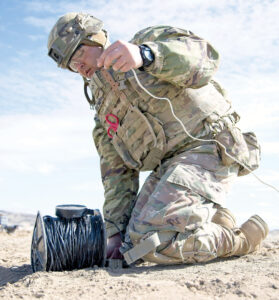14/03/2022 Stati Uniti
“If you ever come across anything suspicious like this item, please do not pick it up, contact your local law enforcement agency for assistance”
By Walter Ham
ABERDEEN PROVING GROUND, Maryland — The U.S. Army is marking the 80th anniversary of the Explosive Ordnance Disposal profession this year. The U.S. Army’s first enlisted EOD technicians began training at the Bomb Disposal School on Aberdeen Proving Ground, Maryland, in April 1942. Based in the science, security and technology corridor of northeast Maryland, Aberdeen Proving Ground is the oldest active proving ground in the U.S. Army and the former home to the Ordnance Corps, which moved to Fort Lee, Virginia in 2008. Aberdeen Proving Ground is the headquarters post for the 20th Chemical, Biological, Radiological, Nuclear, Explosives (CBRNE) Command, the U.S. Department of Defense’s premier all hazards formation. The 20th CBRNE Command is home to 75% of the Army’s active duty EOD technicians and Chemical, Biological, Radiological, Nuclear (CBRN) specialists, as well as the 1st Area Medical Laboratory, CBRNE Analytical and Remediation Activity, five Weapons of Mass Destruction Coordination Teams and three Nuclear Disablement Teams. Col. Christopher P. Bartos, the operations officer for 20th CBRNE Command, is the senior EOD officer at the headquarters. Bartos grew up around the military and graduated from high school at Army Garrison-Kwajalein Atoll in the Republic of the Marshall Islands. He later graduated from Embry-Riddle Aeronautical University in Daytona Beach, Florida, and became a U.S. Army infantry officer. After a few years, he decided to become an EOD officer. “I wanted to explore a different path that would challenge me in a more technical way,” said Bartos. “I was fascinated by the complexity and technology of various types of weapons and other hazards designed for war and conflict. As a young officer, I believed EOD to be a perfect fit of supporting combat operations and protecting our Soldiers.” Bartos oversees operations for the command that has 3,800 Soldiers and civilians who deploy from 19 bases in 16 states to take on the world’s most dangerous hazards. Bartos said 20th CBRNE Command EOD units routinely deploy to the U.S. Central Command and U.S. Africa Command areas of operations while supporting U.S. Indo-Pacific Command exercises and Defense Support to Civil Authorities missions for U.S. Northern Command. EOD technicians also respond when unexploded military munitions are discovered, both on and off post. In 2021, 20th CBRNE Command EOD units participated in 1,415 explosive mitigation missions on military installations and 276 missions off base.
Photo-Source: fortcarsonmountaineer.com
If you find anything that appears to be an explosive device, do not touch it, leave it where it is and call the police. We will contact the appropriate agencies to properly dispose of the item.
Dear editors, Biography of a bomb is aimed at highlighting the danger caused by unexploded bombs. Moreover, the most important aspect is that we work completely non profit, raising awerness about this topic is what drives us. We apologize if we make use of pictures in yours articles, but we need them to put a context in how findings are done. We will (and we always do) cite source and author of the picture. We thank you for your comprehension.





